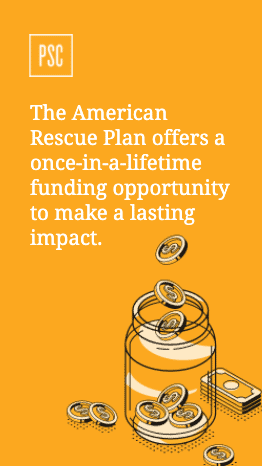The timing seems urgent. The stakes feel high. Everyone is talking about how American Rescue Plan funds need to be used quickly and equitably. Ten years from now, your community could be enjoying the benefits of wise ARP investments, or you could be shaking your head at how swiftly that money was spent on things that didn’t reap long-term rewards.
Michigan and its local governments are set to receive $10.3 billion out of the $350 billion in American Rescue Plan money earmarked for state and local coronavirus relief and economic recovery efforts. After the State takes its cut, and minus the set-aside for capital projects, there will be about $4.4 billion for local governments that will be distributed in three groupings:
- Counties
- Metropolitan cities
- Nonentitlement communities
If you want to be one of the communities that benefits from smart ARP investments for years to come, it is critical to take a breather and think strategically about how this one-time federal aid can make a transformative difference in the lives of the people and the places around you. Local units of government and nonprofit organizations are in an influential position to identify and innovatively solve regional problems with unheard-of federal support. Figuring out how to do this in a future-oriented manner takes informed analysis and efficient implementation.
Source: SEMCOG
State Government
Metropolitan Cities
Counties
Nonentitlement Communities
State Capital Projects
Funding for future prosperity
While ARP money begins flowing into cities and counties, distributing it will require people and organizations working together to coordinate with various groups and execute strategic action. Leaders must focus on building programs and networks that yield a positive impact in the near term and continue to drive equitable growth after the immediate recovery period. Now is the time to think broadly and creatively about critical needs and imaginative partnerships that deliver long-lasting, trajectory-changing results.
To come up with the kinds of transformative ideas that will make this happen, local leaders need to look for unexpected ways to weave together investments and leverage collective impact to achieve a whole that’s greater than the sum of its parts. This will take an understanding of the sheer breadth of federal funding at your disposal and the capacity to deploy these investments in a coordinated, thoughtful and efficient manner. This is a rare opportunity to think big and address economic, health and social challenges that come along with disparate needs and priorities — a chance that should not be squandered by plugging budget holes and making quick fixes.
How we put American Recovery and Reinvestment Act funding to work in Michigan
In 2010, Michigan received $30 million through the American Recovery and Reinvestment Act, the second-largest award out of the $452 million granted by the U.S. Department of Energy (DOE) for the Better Buildings Neighborhood Program. PSC helped the State of Michigan, the Cities of Grand Rapids and Detroit and the Southeast Michigan Regional Energy Office work together, designing and managing the Better Buildings for Michigan program and ensuring state and federal grant compliance as well as evaluating program results. Ultimately, our work was recognized by the DOE as one of the highest-performing grantees in the nation. Because of our guidance, the impact of this one-time investment lives on in the clean energy financing offered by Michigan Saves, as well as through the network of contractors and nonprofits that continue to use the lessons learned through the program to drive demand for clean energy improvements.
Learn more about how we informed use of these funds to improve the energy efficiency in Michigan.
A prime example of this type of solution creation is Michigan Saves, the nation’s first nonprofit green bank, developed with oversight from Public Sector Consultants and funding from the 2010 American Recovery and Reinvestment Act. This organization’s strong commitment to serving individuals with low to moderate incomes extends beyond reducing their energy burden and improving the safety and comfort of their homes — personal health is directly tied to environmental quality. These individuals have the most to gain from clean energy improvements yet have the least access to it. More than 10 years after its creation, Michigan Saves has made over $200 million in energy efficiency and clean energy improvements accessible for thousands of Michiganders. Now, with talks of a national green bank gaining momentum, it serves as a model for using public funds and market-based tools to finance the clean energy transition.
Organizing for an inclusive recovery
The ARP builds on last spring’s Coronavirus Aid, Relief and Economic Security Act and the Coronavirus Response and Relief Supplemental Appropriations Act passed in December 2020. The new law provides additional and still much-needed support for families, small businesses and the overall economy. It includes new initiatives to reach some of the most vulnerable communities and businesses excluded from previous funding packages. Earlier rapid infusions of money taught us that moving resources through existing systems can worsen economic and racial inequality. One of the things the ARP offers to offset this problem is a provision for community navigators to ensure equitable access to capital and technical assistance.
This approach requires organizations that can reach diverse groups and have standing in a broad range of communities. By widening the lens on partnerships and programs, efforts focused on things like decreasing health inequities and increasing healthcare access, creating good-paying jobs and boosting the number of minority-owned small businesses become more viable. Given that communities of color and women have been hardest hit by the collateral damage of the pandemic, a strategic approach to ARP investments may include identifying ways to counterbalance this unequal outcome. Equitable recovery and growth will only be realized if you prioritize robust investments in people, places and projects that make the maximum impact.
More than a rescue mission
In this moment, local leaders and visionaries across sectors have a remarkable opportunity to invest in future growth that’s equitable and transformational. Innovative activities and collaborations, like combining philanthropic contributions and civic leadership to develop new levels of community capacity, must become standard. The ripples of programs created with support of American Rescue Plan dollars can — and should — extend beyond near-term expenditure needs. The pandemic’s chaotic disruption to business-as-usual can be a launchpad to stabilize communities, strategize and organize together and enable an inclusive recovery. This isn’t just about damage control, it’s a chance to equip cities and towns with the ability to build a stronger and more equitable future.



